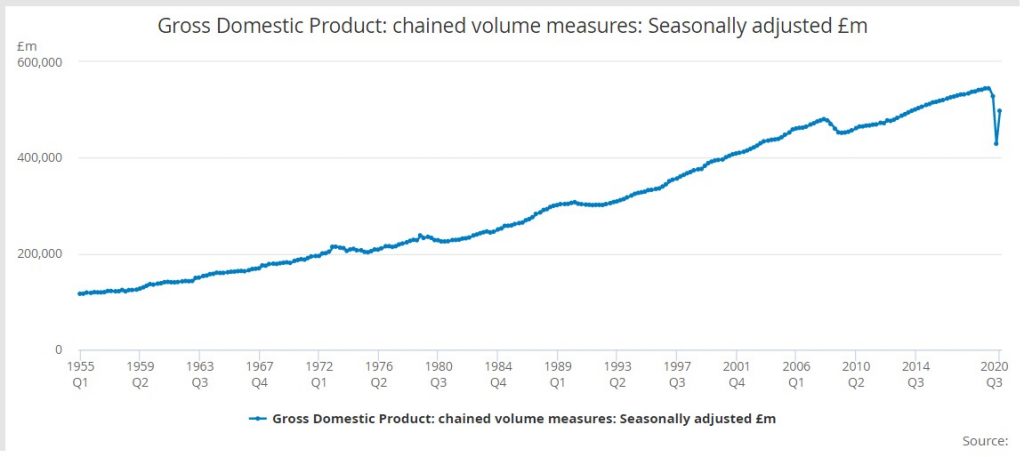Analysis of UK Economy During the Pandemic!
Different lockdown measures were taken in response to the coronavirus, suspending economic development in some industries and seriously disrupting others. It is possible that the resulting job losses and bankruptcies will create significant economic pressures for millions in Europe and around the world.
The European Central Bank has responded in the euro area with strict monetary policy and supervision measures announced on 12 and 18 March 2020. Throughout the European Union, policymakers have begun to declare and introduce different budgetary steps to contain the economic fallout. European state aid laws and fiscal rules have also been suspended.
In this article, we intend to examine the effects of the coronavirus on the GDP of the United Kingdom. With the pandemic hitting Britain with the highest rates of fatalities in Europe, the UK economy has been largely influenced by its consequences; the GDP shrank and predictions were that: “forecasters do not expect the UK economy to regain its pre-Covid size until the end of 2022” (Milliken & Bruce, 2020).
There are a number of reasons for this kind of downturn in the UK compared with that of its neighboring countries, such as Germany and France, including the reliance of the UK economy mostly on ‘consumer spending’ and the fact that several lockdowns were longer than other countries (Nelson, 2020).
According to the Office for National Statistics (ONS), GDP estimates for the UK in the second quarter of 2020 have fallen by 20.4 % (Figure 1), which has been unprecedented since 1955 (Figure 2), “the worst recession since the government started keeping records in 1955 and takes the UK economy back to the size it was in 2003” (Nelson, 2020). The ONS report states that this is due to “the direct effects of the coronavirus (Covid-19) pandemic and the government measures taken to reduce transmission of the virus” (ONS, GDP monthly estimate [of] UK June 2020, 2020).
UK Economy Statistic
According to statistics and economic charts available on official sites related to the pre-Covid-19 period in the UK, as well as economic charts during the Covid period, we are witnessing a sharp decline in economic indicators like the GDP. Other indicators, such as supply and demand charts, show that income and unemployment have also changed as a result of this pandemic.


As shown in Figure 2 and Figure 3, the “GDP grew by 8.7% in June 2020” as compared to April 2020, “but is still well below the levels seen in February 2020”.




ONS Analysis:
The quarterly increases in services, production and construction output in Quarter 3 (July to Sept) 2020 were the largest on record, mainly reflecting the easing of lockdown restrictions through this three-month period and base effects from the steep contractions of the second quarter (Apr to June). Services output grew by a revised 14.7% in Quarter 3 2020, while production output increased by a revised 14.7%, and construction output expanded by a revised 41.2% (Figure 4).
Despite growth in the latest quarter, the levels of output for these sectors remain below those seen before the impact of the Coronavirus (COVID-19) pandemic, the extent of which varies within these industries. Today’s estimates show that output levels in services, production and construction in Quarter 3 2020 were 8.9%, 6.2% and 7.0% below their Quarter 4 (Oct to Dec) 2019 levels respectively. New York times (Nelson, 2020)
Britain was also more vulnerable to the economic impact of social distancing measures because of its large services sector. In the second quarter, spending on accommodation and food services — a category that includes hotels and restaurants — plunged by 87 percent.
Conclusion
As mentioned at the beginning of the article, all countries, including the United Kingdom, have experienced a severe recession during the coronavirus pandemic; in other words, 2020 began with an economic crisis. In many countries, essential items (masks, disinfectants, and food) were in short supply, and hospitals were overcrowded with Covid patients. Therefore, all countries had to set up field hospitals at the same time.
Meanwhile, in the first quarter of 2020, the economic index of countries, such as GDP, fell sharply, and the global economy was disrupted. Therefore, country policies to restore the economic situation to the pre-Covid period were to implement long-term and short-term plans and to support people, companies and institutions.
Accordingly, although Britain was one of the countries with a very high number of victims, it was able to bring the economic situation close to a similar period last year.

